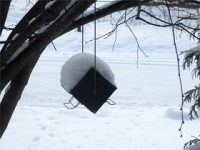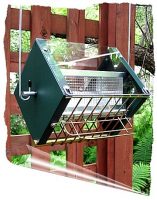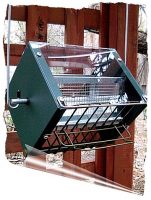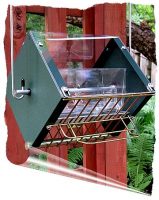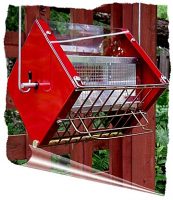Animals & Bird Problems
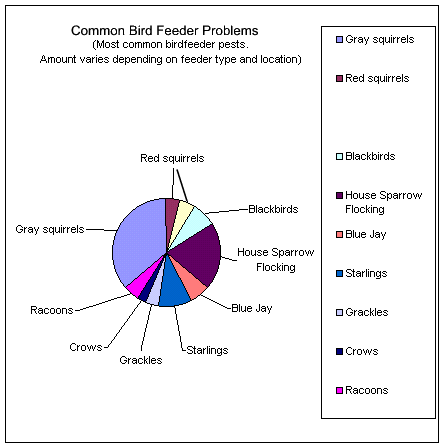
- Deer can be very problematic with bird feeders – their height is close to the height of pole hanging feeders so that makes it easier for them to pilfer bird seed. Typically they will extend their tongue and lick at the feeder to pilfer seed. Sometimes they will jump at a feeder and try to knock seed out with their front legs.
- Rollerfeeder’s spinning/rotating housing closes on Deer the same way it does when a squirrel or other animals puts weight on the feeder.
- The best position for Deer is above or below head height so when they put weight on the feeder is closes – try to avoid directly across from head height.
- We do not guarantee our product deer-proof due to the many variables out of our control, however many customers with deer problems purchase our product and report back with deer-proof type responses.
- Some customers that have rat problems in their feeders do have some success using a Rollerfeeder if the rats are larger size.
- Rats sizes vary too much to have a warranty to prevent them.
- Rats are very difficult to test against so we don’t have any policy regarding rats.
- In general, we recommend following our same suggestions for chipmunks as we do for preventing rats.
- The same thing applies to Flying squirrels as it does for chipmunks – with the exception they can jump (or fly) much longer distances to gain access to a bird feeder.
- There is no such thing as a flying squirrel proof bird feeder, when manufacturers refer to squirrel proof they are referring to the number one trouble maker with birds feeders, grey squirrels.
- Flying squirrels are like a large mouse – a lot of their size is perceived because of the skin folds they use to fly. Their small mouse-like size allows them to crawl through the smallest openings.
- Rollerfeeder will not prevent chipmunks from gaining access to the feeder. This is typically true with all feeders on the market if chipmunks can gain access to the feeder.
- There is really no such thing as a chipmunk proof bird feeder that we are aware of.
- Bird feeder makers that design feeders to prevent squirrels call them squirrel proof with no word of chipmunks – some work better than others at preventing squirrels. Rollerfeeder is guaranteed squirrel proof.
- Chipmunks are very small, light, and agile with the ability to crawl through small openings if they can gain access to the feeder.
- However, It is easy to prevent chipmunks by placing the feeder above a pole baffle/dish so they cannot bypass the baffle – typically larger squirrels can bypass pole baffles by jumping up or across or down from another location – but chipmunks don’t have the ability to jump very far.
- Chipmunks cannot jump like larger grey squirrels so considering placement, and baffles blocking access to the feeder is important in preventing them.
About chipmunks and bird feeders.
There is a common notion that squirrel proof bird feeders will automatically prevent the smallest animals like chipmunks, rats, gophers, very small flying squirrels, and even mice. The truth is there is no bird feeder on the market (that we know of) that claims or advertises to be chipmunk proof or rat proof or mouse proof – or is effective (with guarantee or warrantee) at preventing chipmunks if they can gain access to a bird feeder.
Bird feeder designs.
Squirrel proof feeders are designed for your garden variety grey squirrels and other squirrels similar in size. Grey squirrels are many times larger and heavier than the smaller animals mentioned above, a good guess is grey squirrels are at least 4-5 times larger and heavier than most chipmunks. The smallest rodents are too small, agile, and light to keep out of bird feeders. Smaller animals can climb through very tight openings and are not heavy enough to close mechanisms that are designed for heavier squirrels.
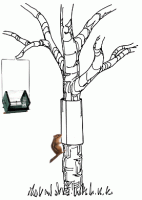 Chipmunks and bird feeders hung from tree branches.
Chipmunks and bird feeders hung from tree branches.
A sheet metal tree skirt is an example of how to prevent chipmunks and other smaller animals from climbing trees to gain access to the bird feeder by crawling up the tree and jumping down or over from a tree limb. With a Rollerfeeder you will not have an issue with squirrels since we guarantee it will prevent them.
Chipmunks gaining access to bird feeders.
If a chipmunk or other small animal like rats can gain access to a bird feeder, then you can be assured it will crawl in the feeder or perch somewhere on the feeder to pilfer bird seed. Many areas of the country have problems with rats in their bird feeder, as an example the citrus rat in Florida, or areas of the country that grow citrus trees.
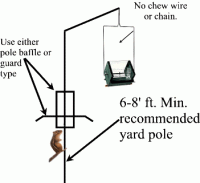 Chipmunks and bird feeders hung from yard poles.
Chipmunks and bird feeders hung from yard poles.
Add an inexpensive dish or tube type baffle/guard to a yard pole to prevent access from troublesome smaller animals like chipmunks. Be sure the pole is placed far enough from a jumping or launch pad so the chipmunk can’t jump over from the side area like a deck railing, tree, shrub or other jumping location.
Preventing access the best approach.
The best way to prevent small animals like chipmunks is to prevent access to the bird feeder. This can be done with the location of the feeder and a couple DIY or store bought widgets that prevent them from climbing to the feeder i.e. skirts or baffles or a guard of some type. Chipmunks cannot jump like larger grey squirrels so considering placement, and baffles blocking access to the feeder is important in preventing them. See more examples below.
Preventive and proven techniques for smaller animals.
Sometimes just hanging a feeder in a tree is enough to discourage chipmunks, however some of the bravest chipmunks will crawl up the tree and jump to the feeder. Use inexpensive baffles and guards that help prevent access to the feeder. If your feeder is hung in a tree, another method is to use a metal skirt around the base of the tree. You can also use a dome on top of the feeder if you don’t want to add a metal skirt. If using a dome – be sure to hang the bird feeder far enough away from the trunk so the chipmunk or rat can’t jump over from the side. These techniques are proven in the field and are very effective. These techniques will not prevent squirrels from accessing the feeder because of their agility and jumping abilities, but a RollerFeeder is guaranteed to prevent the larger squirrels so you don’t have to worry about squirrels.
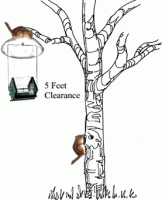 Chipmunk proofing using an overhead dome baffle.
Chipmunk proofing using an overhead dome baffle.
Sometimes using an overhead dome can be effective if the feeder is far enough away from the tree trunk to force them to crawl down from above. The chipmunk will typically slip on the dome and fall to the ground without touching the feeder, but not always. Try to maintain 5 feet of horizontal clearance from the trunk or other horizontal location they could jump from. Preventing access using a skirt or baffle on a pole or tree trunk is the most effective method.
- Raccoons are very large and cause havoc with bird feeders, they are many more times difficult than squirrels to keep from pilfering bird seed.
- Customers that purchase RollerFeeder and follow our suggested hanging instructions have good results in preventing raccoons.
- See the Raccoon page for more detailed information on placement and hanging the feeder for raccoons.
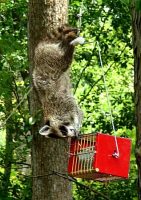 The photo is from one of Rollerfeeder Owner’s that has Raccoon problems, in addition to constant grey squirrel problems living near a deep woods area. The large Raccoon is attempting to defeat the feeder by hanging down from above because if it crawls to the feeder box, Rollerfeeder spins mechanically to dislodge the animal. The internal seed hopper stays upright while the built-tough double sided housing with perches freely rolls around 360 degrees.
The photo is from one of Rollerfeeder Owner’s that has Raccoon problems, in addition to constant grey squirrel problems living near a deep woods area. The large Raccoon is attempting to defeat the feeder by hanging down from above because if it crawls to the feeder box, Rollerfeeder spins mechanically to dislodge the animal. The internal seed hopper stays upright while the built-tough double sided housing with perches freely rolls around 360 degrees.
How to hang Rollerfeeder for Raccoon problems.
For Raccoons, the Rollerfeeder needs to hang in a location with adequate clearance so that the animal is forced to crawl down from above, this will produce the best results in preventing Raccoons. Using strong wire or cable, the feeder should hang down 12″-18″ or longer from a horizontal line or branch or other horizontal support – this is due to very large raccoons that can be 20-30 lbs and length of 30″ or longer. Make sure the connections from the horizontal member and feeder hanger are tight and secure.
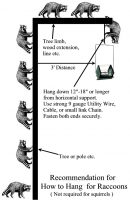
- Crows: Rollerfeeder prevents all crows.
- Grackles: Rollerfeeder is highly effective at preventing grackles.
- Pigeons: Rollerfeeder is highly effective at preventing pigeons.
- Morning Doves: Rollerfeeder prevents morning doves.
- Larger Blue Jays (American Blue Jay): Rollerfeeder is effective at preventing most larger blue jays – smaller scrub jays can likely adapt to the feeder..
- Cowbirds: Effective against cowbirds.
- * Starlings: Effective at preventing Starling – see below note.
- * Red-winged Blackbirds: Mostly effective – see below note. See video below.
Notes:
- Generally speaking the larger the bird the more effective Rollerfeeder is in preventing them. Crows and other larger birds, Rollerfeeder is typically 100% effective at keeping them from pilfering seed. Birds closer in size to a cardinal such as Starlings and Red-winged Blackbirds can land on the feeder but they tend to flutter and flap their wings and give up in a short time. There is a very fine line between allowing Cardinals and preventing the smaller nuisance birds like Starlings – the easier a feeder is for Cardinals the easier it is for birds similar in size like Starlings and smaller blackbirds.
- Although the feeder is effective against larger nuisance birds, we do not guarantee 100% large-bird proof due to the wide range and types of larger birds out there. Please read our testimonials regarding the prevention of large nuisance birds.
- If you have flocks of nuisance birds – use black oil sunflower seed in the shell and block one side of the feeder this will help prevent them from counter balancing on both sides.
- Red squirrels act very much like above grey squirrels, they are lighter and more agile in their efforts to defeat the feeder.
- Due to the smaller and wider size variations of the red squirrel, RollerFeeder markets the design as highly effective against red squirrels.
- Our current models using wire grid has been in the field for over 5 years in red-squirrel country without them breaching the design. Many customers purchase our feeder for small red squirrel problems and write to us about their success
- Grey squirrels will often roll off the feeder but not every time.
- Sometimes grey squirrels will crawl and befuddle around on the Rollerfeeder, and sometimes they will hang from the bottom trying to figure out the design.
- They will also crawl down the hanger side and try to reach around – the feeder housing turns and closes access to the seed trays when they attempt from the side.
- They will often hang on the feeder and stick their nose through the grid but at an angle that prevents them from accessing the seed tray.
- Rollerfeeder is guaranteed grey squirrel proof and other medium-large size squirrels.
Bird Types
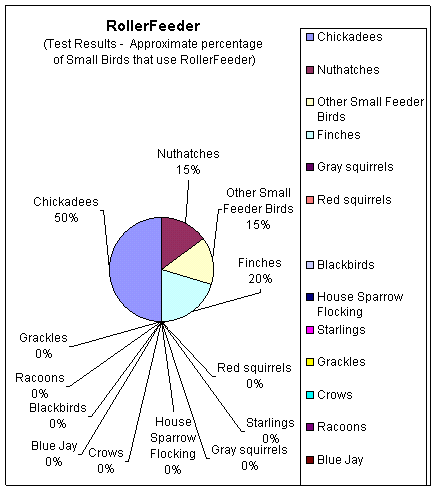
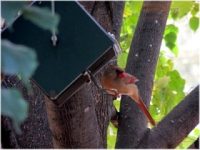 Make sure Rollerfeeder is hung high enough (5′-6″-8′ min.) so the flying approach is adequate. Cardinals need much more room than smaller birds to fly in and land on feeders. Avoid plant yard hooks that are low to the ground, use yard hooks designed for birds feeder which are much taller with wider hooks.
Make sure Rollerfeeder is hung high enough (5′-6″-8′ min.) so the flying approach is adequate. Cardinals need much more room than smaller birds to fly in and land on feeders. Avoid plant yard hooks that are low to the ground, use yard hooks designed for birds feeder which are much taller with wider hooks.- Use mostly sunflower hearts (50%) mixed with black oil sunflower (25%) and safflower seed (25%), OR 100% sunflower hearts. Customer’s that use this seed mix have the best results with Cardinals.
- Cardinals usually acclimate to the Rollerfeeder in due time, if they are having trouble, tie a small helper stick (twig/small branch) on the perch with thin wire or string – this should help assist a Cardinal land and acclimate to the feeder. Be aware it might also assist larger nuisance birds land and possibly feed. Don’t allow the twig to interfere with the rolling housing.
Cardinal Helper Perch Ideas
- Many customers get visiting cardinals without helper perches, for some the feedback for helper perches is that they seem to make it a little easier for the larger cardinal to land and access the seed.
- Tie a twig on or stick with blunt ends, nothing with sharp or pointy ends or sticking straight out, at an angle or to the side is best. It could be as simple as a popsicle stick with rounded edges or a tree stick with rounded edges, try to use something natural first.
- Use a commercial 18″ “gear tie and loop from one perch to the other as shown in below photo links. Gear ties can be found in many stores including home depot > Home Depot Gear Tie
- Photo of Cardinal with tree stick attached > Stick Cardinal Helper
- Photo 1 of Cardinal with Gear Tie > Gear Tie Cardinal Helper
- Photo 2 of Cardinal with Gear Tie > Gear Tie Cardinal Helper
- Photo 3 of Cardinal with Gear Tie > Gear Tie Cardinal Helper
- Photo 4 of Cardinal without Helper > No Helper-1
- Photo 5 of Cardinal without Helper > No Helper-2
- Photo 6 of Cardinal without Helper > No Helper-3
- Photo 7 of Cardinal without Helper > No Helper-4
- Photo 8 of Cardinal without Helper > No Helper-5
- Video 1 of Cardinal without Helper > No Helper Video
- Video 2 of Cardinal without Helper > No Helper Video
Cardinals General Information
- Based on Customer photos, 100s of testimonials, and our own testing, Rollerfeeder will accommodate bird sizes Chickadee up to Cardinals. Cardinals can often take a while because they are at the high end of the bird size RollerFeeder will accomodate, and also because of their skittish personality and natural feeding habits. Cardinals are ground feeders by nature and will typically always feed from the ground first if seed has dropped below feeders. read more below.
- A Cardinals personality is more skittish and nervous than smaller bird feeder visitors. Cardinals tend to be more leery and cautious when flying around, perching, and trying out new feeders. The slightest movement will send them flying away compared to a fearless chickadee that will eat from your hand.
- RollerFeeder has been tested by a nation-wide bird feeder supply store and it past their testing for birds sizes Chickadee – Cardinals.
- We also receive customer e-mails often about Cardinals using their feeder. .
- Cardinals visit our test feeders on a regular basis. They may be more prevalent during certain times of the year like winter or late fall. Natural food supplies can affect how often Cardinals visit – if natural food sources are abundant in your area they will typically feed from natural food sources first.
- Keep in mind, Rollerfeeder is also designed to help prevent larger nuisance birds like Blackbirds which are very close in size (slightly larger) to a Cardinal.
- It may take more time for Cardinals to adjust to the design compared to small-medium size birds like a chickadee, nuthatch, finch, tufted titmouse, or other smaller birds.
- Cardinals have a wider flying pattern/approach whereas small birds can zip in & out of a feeder location. Make sure it is high enough and some room to maneuver and approach the feeder.
- Cardinals are considered “ground feeders” which means their natural method of feeding in the wild is hopping around the ground looking for berries and seeds. Read more about feeding habits and diet of Cardinals on Wikipedia > http://en.wikipedia.org/wiki/Northern_Cardinal#Diet
- If there is seed on the ground, Cardinals will almost always feed from the ground first before going to feeders.
- Some customers get Cardinals coming to their feeder early and often and others have more waiting time – we are not sure why but think the existing food source, regional sizes, type of seed, height of feeder and location of feeder play a role in customer’s success with Cardinals.
 Below listed are the most common woodpeckers that visit Rollerfeeder.
Below listed are the most common woodpeckers that visit Rollerfeeder.- Hairy woodpeckers.
- Downy woodpeckers.
- Red-Bellied woodpeckers.
- Amount of woodpecker visits and types depend on your bird environment.
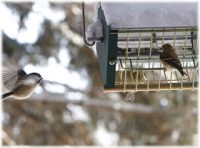 Rollerfeeder is designed for small to medium size songbirds up to Cardinal size. The list includes favorites like Chickadees, Nuthatches, Finches (Gold/Purple/House/Other), Tufted Titmice, and other small medium size birds.
Rollerfeeder is designed for small to medium size songbirds up to Cardinal size. The list includes favorites like Chickadees, Nuthatches, Finches (Gold/Purple/House/Other), Tufted Titmice, and other small medium size birds.- Some customers report Wrens, Painted Bunting, and other less common medium size birds.
How It Works
Patented counter-balancing feature harmlessly ejects squirrels and helps to prevent loitering. The two-sided seed hopper stays upright while the exterior shell pivots around, keeping the seed intact and the squirrels at bay. Also, heavier birds will tilt the RollerFeeder just enough to prohibit them from feeding from the tray, this unique design is adjustable with weights provided.
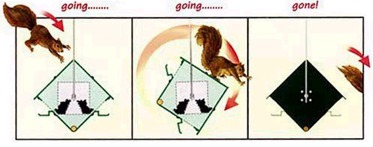
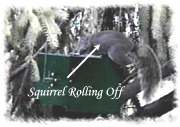 The RollerFeeder has been tested and in the field (customer owned) since 1998. The test sites are located in the northern woods, suburbs, and city environments. In most cases, the feeder hangs directly from a tree limb or hanger without other squirrel deterrent devices (guards etc.). RollerFeeder has consistently prevented feeder problems such as rodent animals and birds i.e. Grey squirrels, Red squirrels, Raccoons, Starlings, Blackbirds, etc. RollerFeeder also has its own on-going test site with three feeders, they hang in the middle of a large pine tree with several branches nearby to make it easy for squirrels to launch from.
The RollerFeeder has been tested and in the field (customer owned) since 1998. The test sites are located in the northern woods, suburbs, and city environments. In most cases, the feeder hangs directly from a tree limb or hanger without other squirrel deterrent devices (guards etc.). RollerFeeder has consistently prevented feeder problems such as rodent animals and birds i.e. Grey squirrels, Red squirrels, Raccoons, Starlings, Blackbirds, etc. RollerFeeder also has its own on-going test site with three feeders, they hang in the middle of a large pine tree with several branches nearby to make it easy for squirrels to launch from.
 A seed container is bolted to a shaft. The outer shell spins around the seed container in a clockwise or counter-clockwise rotation. The shell includes a perch platform, a counter-balance, and a window opening that permits access to the feed ports by small birds. When a rodent animal or large bird climbs or lands on the feeder, the rotating shell dislodges the unwanted visitor and closes access to the seed tray.
A seed container is bolted to a shaft. The outer shell spins around the seed container in a clockwise or counter-clockwise rotation. The shell includes a perch platform, a counter-balance, and a window opening that permits access to the feed ports by small birds. When a rodent animal or large bird climbs or lands on the feeder, the rotating shell dislodges the unwanted visitor and closes access to the seed tray.
A RollerFeeder is a bird feeder that fully spins in a clockwise or counter-clockwise direction. The feeder allows small birds to feed while preventing squirrels and large birds from feeding. The feeder typically hangs directly off a tree limb, tree trunk (or any horizontal extension) and is best for birds such as chickadees, finches, nuthatches, titmice, and other small birds. When animals such as squirrels, raccoon’s, or large birds climb or land on the feeder, the outer shell, perch, and shaft sleeves spin. The fully rotational design prevents the unwanted visitor from resting or climbing about the feeder, and at the same time, closes off access to the feed ports. Afterwards, the shell quickly rocks back into feeding position and is ready for the next chickadee to come along.
Seed stay intact untouched while the housing spins
Does not roll or spin with birds – birds feeding on both sides.
Product Questions
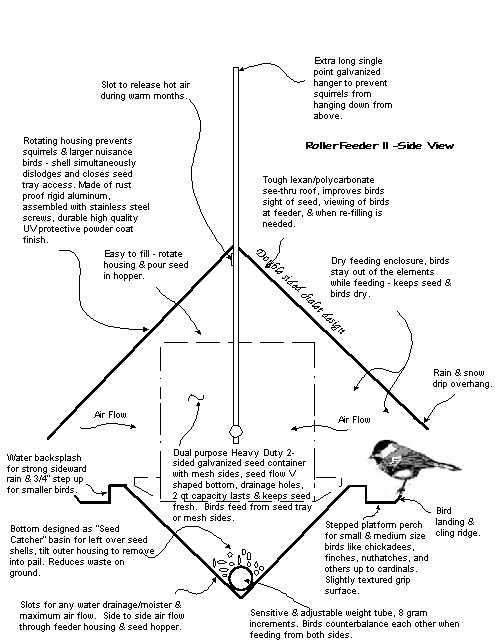
- All Rollerfeeder squirrel proof bird feeder parts are Made in USA.
- All Rollerfeeder assembly is in the USA.
- We use over 25 U.S. suppliers to deliver a Rollerfeeder to a customer’s doorstep.
- Rollerfeeder sources parts from the upper Midwest, Midwest, and Eastern United States.
- Rollerfeeder is designed and made in Minnesota.
- The original inventor and owner still runs the small company and designs all the parts for Rollerfeeder. Rollerfeeder has been in business since 1998.
Rain & Snow
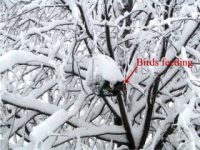 We consider Rollerfeeder a rain proof bird feeder, the roof angle prevents all regular rain and it is effective under most stormy conditions. The benefit is the rain prevention feature is built-in and does not require an overhead dome which can cost $20-$30 or more.
We consider Rollerfeeder a rain proof bird feeder, the roof angle prevents all regular rain and it is effective under most stormy conditions. The benefit is the rain prevention feature is built-in and does not require an overhead dome which can cost $20-$30 or more.- Rollerfeeder will prevent snow in many conditions especially if the snow is dry and fluffy, we would consider Rollerfeeder snow resistant but not snow proof – see next comment.
- Heavy Wet Snow 1: For wet heavy snow, if the snow is deep and heavy enough, the weight of the snow will turn the feeder since the snow is heavier than the counterbalance weight at the bottom of the feeder. If this condition occurs simply wipe the snow off with a broom or your hand and it will correct itself. Try to keep ahead of the snow build-up if you can.
- Heavy Wet Snow 2: If you live in an area where heavy wet snow occurs often, the best defense is a cover above or hang in an area that provides natural cover, or under an overhang etc.
Parts – Suet Feeder Conversion
Steel seed hoppers are available to convert the suet feeder into a seed feeder. To order the seed hopper, write steel seed hopper in the comments sections of the order form – the cost is $14 plus shipping. The cost of the part is a couple dollar increase from our cost.
Replacement of perches.
- Due to large animal feeder problems including bear, raccoons, deer, large possum, and other large animals, perches are separated from the lifetime housing warranty. We rarely have issues with perches and if perches are bent by a large animal, most of the time they can be bent back into place with little effort.
- The perches allow for some flex and up/down adjustment by lightly moving them in the direction you want to. They are best adjusted so the main landing section of the perch is horizontal with the ground or with slight angle up a few degrees.
- If you have ongoing problems with large animals and they are damaging the perches on a regular basis, we have extra heavy-duty perches available for near our cost. The heavy duty perches are nearly twice as thick and rigid as the standard perches.
- Email for the Heavy-Duty perches cost and our standard flat rate shipping to cover postage, packaging materials & handling, and trip to the post office.
- To order only the Heavy-Duty perches fill out the order form (without selecting a feeder) and write Extra Duty Perches in the Comments Box of the order form. Also include the Color of the Perches you want either Gold or Moss Green.
- During the first year of ownership, if you are having problems with the perches and it is not due to larger animals like raccoons, bear, deer, abuse etc. E-mail us a photo with explanation and we will review your request. See our warranty page for a full explanation of what is covered.
- The extra-duty accessory is designed for older models with metal pan bottom.
- The accessory makes the older RollerFeeder heavy duty preventing any squirrel attempts.
- The extra-duty accessory does not fit or work with the newer wire grid model feeders.
- The newer style feeders have been on the market for over 5 years and incorporates the extra-duty accessory feature into the feeder – without the extra cost.
- Hanger: Galvanized Steel.
- Feeder Sides: Aircraft quality aluminum with commercial grade powder coating paint.
- Roof: High impact resistant Polycarbonate plastic – this high grade plastic is also used in motorcycle windshields and other commercial products.
- Plastic Hoppers: Polycarbonate plastic with steel seed tray edges.
- Steel Hoppers: Galvanized Steel frames with Stainless steel mesh sides.
- Suet Hoppers: Galvanized Steel frame and sides.
- Roof Edge: Stainless Steel.
- Axle: High grade Aluminum.
- Hanger Dimension: 12″ Wide X 21″ High – the length of the hanger is required to prevent large squirrels and animals from hanging down from above. Squirrels will pilfer seed from a short hanger feeder or feeder with seed posts at the top of the feeder.
- Feeder Housing Dimension: 9″ Wide X 6 1/2″ Square with extending perches on 2 sides of the feeder.
- Overall Dimensions: 12″ Wide X 24″ High
- Weight: 3-4 pounds depending on model and seed used.
- Seed Capacity Standard Hopper: Plastic or steel hopper 2 Quarts.
- Extra Capacity Hopper: Available in steel only 2.5 Quarts
- Approx. 2-3/4 lbs of seed using sunflower hearts & extra capacity hopper.
- Even though we consider the Rollerfeeder to be a dishwasher safe bird feeder, we highly discourage you from cleaning a bird feeder in the dishwasher for the following reasons:
- We consider “Dishwasher safe” a marketing gimmick since most bird feeders can be washed in the dishwater with little to no damage on the proper dishwasher setting and rack placement.
- The main issue is you are likely introducing possible bird soiling and possible bird diseases into your dishwasher – which we all know is for your dishes you use to eat from. There is no scientific evidence these germs and bacteria are killed during the dishwasher cycle so why take the chance.
- Birds can spread bacterial diseases using their beaks from one feeder to another where other birds contract the germ. These germs or viruses can be on the bird feeder and when another bird uses the feeder it catches the germ.
- Soiling is another common issue – even though birds feed mostly outside the seed area – they soil in many other areas while accessing the feeder and vying for a place to feed.
- We recommend avoiding the dishwasher to clean any feeder and just use a warm pale of water, or wash tub with mild detergent and rinse thoroughly with warm/hot water and let dry completely.
- Clean by using a garden hose or tub hose and spray the inside of the feeder gently (using preferably warmer water).
- You can remove the roof for a more thorough cleaning to gain access to the inside of the feeder housing and easy access to the seed hopper..
- Use mild dish soap and soft rag for wiping the parts clean.
- If you use a tub, soak in warm/hot water to loosen the debris before wiping the debris out.
- Rinse thoroughly with warm water to remove any left over soap and bird seed debris.
- Let completely dry before filling with seed and hanging.
- We do not recommend disassembly of the entire feeder unless you are mechanically inclined – however the feeder is designed to replace any part if ever needed and comes apart with Phillips a screw driver.
- We believe Rollerfeeder seed feeders are the easiest feeders on the market to fill.
- Simply turn the outer feeder housing 90 degrees, using a plastic water pitcher filled with seed or other container, pour seed slowly into the open hopper. Once filled let go of feeder housing and the Rollerfeeder will correct itself into feeding position.
- There is no need to take the feeder down, or caps to remove, no locking clips to unlock, or other security measures other feeders makers employ to keep squirrel out. Turn housing and pour seed slowly into hopper – you do need to aim a little while you’re pouring the seed.
- Rollerfeeder is a hanging style bird feeder as apposed to a pole mounted feeder.
- Rollerfeeder needs to hang to allow the outer housing to roll and spin when squirrel tries to defeat the feeder.
- The hanger is one piece and comes together at the top (as photo illustrates) with a center bump for hanging – it can be used with wire or chain or hang directly from a yard hook.
Steel Seed Hopper
2 Full length feeding trays & stainless mesh sides.
- Steel Seed Hopper is more heavy duty than plastic for tough animal problems like raccoons or large aggressive squirrels.
- Steel Seed Hopper has stainless steel mesh feeding sides and full length trays (both sides). Birds can pick seeds from the sides of the hopper or seed trays. There is also more exposed seed to pick seeds from the sides or trays.
- Steel Seed Hopper has tighter seed trays to prevent seed spillage during aggressive squirrel attempts.
- Steel Seed Hopper accommodates black oil sunflower seed or sunflower in the shell/sunflower hearts/safflower mix/small peanut parts. This seed mix is considered one of the best bird seed mixes.
- Mesh sided hopper can also be used as a squirrel proof peanut-parts feeder.
- Steel Hopper is available in 2 quart (standard) or 2.5 quart extra-capacity size with 25% more capacity. Approx. 2-3/4 lbs of seed using sunflower hearts & extra capacity hopper.
Polycarbonate Plastic Hopper
2 Full length trays with steel edges.
- Plastic hopper accommodates all seed types.
- Plastic Hopper has full length seed trays, both sides – the seed trays are a little larger than the steel hopper.
- Plastic Hopper is medium-duty versus more heavy duty steel above.
- Plastic Hopper has steel tray edges to prevent squirrel damage, Steel is built-in.
- Plastic Hopper is clear for a little better view of the bird seed but both hopper types do well since the seed is exposed in the steel mesh sides, shown in above feeder.
- Plastic hopper is available in 2 quart capacity hopper size. Approx. 2-1/4 lbs of seed using sunflower hearts.
Examples
Example #1 – Forest Green Sides, Gold Wire, Steel Seed Hopper
Example #2 – Forest Green Sides, Satin Black Wire Wire, Steel Seed Hopper
Example #3 – Green Sides, Gold Wire, Polycarbonate Plastic Hopper
Example #4 – Red Sides, Gold Wire, Steel Seed Hopper
- Side Color? (Red or Green) – The Color of the sides is personal preference, the best selling color is Forest Green. Models with Red sides are popular as gifts, there is no difference in performance between the two colors.
- Wire Finish? “Copper-Gold Iridescent” or “Satin Black” – The color of the wire is mostly personal preference, both finishes have similar weather resistance properties. Satin Black is a solid coating and it has a UV Topcoat. The black tends to blend-in more with the forest green sides and it has a more subtle look. The Black Satin Finish is best selling finish and most popular finish. The Copper-Gold Iridescent finished wire is also weather resistant and an accent to the green or red sides. The Copper-Gold wire can change between copper and gold depending on viewing angle and sunlight. Copper-Gold tends to have a custom-crafted appearance (compared to a solid color) because each part turns out a little different during the finishing process. We have named both colors “Goldfinch Copper-Gold Iridescent” and “Black-Capped Chickadee Black”.
- Seed Hopper? (Polycarbonate Plastic or Steel) – The Seed Hopper choice is the biggest difference in the models – read about the hopper differences below.
RollerFeeder Benefits
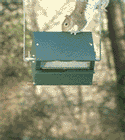 The innovative mechanical design works without wires or batteries that can add ongoing costly battery replacement and hassle by needing to monitor the batteries useful charge life. More importantly, there is no need to throw away wasted batteries to land fills unnecessarily, it works every day of the year, with the environment in mind. Battery or shock feeders are primarily intended to fend off squirrels which still leaves the rest of the problems….pest birds such as starlings, house sparrows, blackbirds, crows, cowbirds, grackles, pigeons, and many other pest birds to contend with.
The innovative mechanical design works without wires or batteries that can add ongoing costly battery replacement and hassle by needing to monitor the batteries useful charge life. More importantly, there is no need to throw away wasted batteries to land fills unnecessarily, it works every day of the year, with the environment in mind. Battery or shock feeders are primarily intended to fend off squirrels which still leaves the rest of the problems….pest birds such as starlings, house sparrows, blackbirds, crows, cowbirds, grackles, pigeons, and many other pest birds to contend with. The “active” rolling design prevents animals and unwanted large birds from resting or climbing on the feeder at will, and helps to deter loitering, additionally closing access to the feed trays while they are being spun off.
 RollerFeeder’s unique “active” rotating design does not allow the animal or large bird to climb about the feeder housing or land and search for alternate methods to access the seed. It’s multi- functional design not only closes access to the seed trays, but also dislodges the unwanted visitor, deterring loitering. After a while they simply give up and no longer try.
RollerFeeder’s unique “active” rotating design does not allow the animal or large bird to climb about the feeder housing or land and search for alternate methods to access the seed. It’s multi- functional design not only closes access to the seed trays, but also dislodges the unwanted visitor, deterring loitering. After a while they simply give up and no longer try.
RollerFeeder’s “self-contained” design means that you can hang it right from a tree limb or horizontal extension. It does not require additional guards, special poles, or any other squirrel deterrent devices to operate. R-Feeder also does not allow large unwanted birds to land and feed.
The built-in design allows complete access to the feeder and welcomes all typical problem animals and birds. It is when the animal or large bird commit themselves and climb, land, or jump on the feeder is when they are suddenly taken by surprise.
RollerFeeder is Squirrel Proof & Pest Bird Proof preventing larger gray squirrels & others similar in size. Also the RF with prevent larger nuisance birds like starlings, blackbirds, grackles, crows, cowbirds, ravens, pigeons, and other larger undesirable birds. You will never see a blackbird or starling or crow on a RollerFeeder for more than a few seconds.
Squirrel Proof Bird Feeder is a common phrase, we back it up with a guarantee that covers red squirrels, gray squirrels & other rodents similar in size. R-Feeder also prevents larger nuisance birds, and greatly minimizes usage by house sparrows, they can sometimes be as big or bigger problem than squirrels
Warranty and Refund Policies
RollerFeeder will replace or repair, at our option, for lifetime ownership, any assembly housing metal piece that impedes the functional operation of the feeder. This warranty does not cover abuse or other non-squirrel related damage. Parts include metal main housing sides, and primary grid, or bottom pan sections. Shipping charges of any parts apply. Due to large animal problems like bear, large raccoons, deer, and others, wire perches are excluded from the main housing warranty.
RollerFeeder’s refund policy is simple: If you are not satisfied with the RollerFeeder upon receiving the feeder, just return the product in New (unused) condition , in the original box, within 7 business days for a full purchase price refund of the feeder product cost (Excluding shipping costs either direction). After 7 business days in New/Unused condition there is a minimum 10% restocking charge on new product returned, email us for a Return Restocking Rate schedule at info@rollerfeeder.com. The RollerFeeder must be in New/Unused condition for a full refund and you must obtain an authorization number by e-mailing us. We will not accept or approve a full refund if the product has been used outdoors in any way, or used on a trial basis for any period of time (hung outdoors, filled with seed, or both). Our policy is consistent with major bird feeder sellers like Wild Birds Unlimited and most On-Line Sellers of bird feeders, however, no merchant will match our lifetime squirrel-proof guarantee. Our policy is limited to the construction and operation of the feeder upon receipt of the feeder, and the product being squirrel -proof where the guarantee is outlined above. The return policy excludes the timeframe it takes for birds to adjust to, and use a new feeder because it varies greatly with all feeders (or bird traffic). Depending on your Geographical Area, Feeder Placement, Landscaping Environment (trees/shrubs/gardens), Bird Seed Choice, Season, Migration Patterns, Competing Feeders, Natural Food Supply, and many other factors, birds usually start visiting a new feeder ranging in time from just a few days to several weeks, sometimes it can take longer. Due to many variables mentioned above that affect when birds start to use a new feeder, our warranty/guarantee and return policy does not cover individual results, satisfaction of bird traffic results, or bird types (this policy is also consistent with over 90% of bird feeder sellers and makers of bird feeders).
Lifetime Housing Parts Warranty
RollerFeeder will replace or repair, at our option, for lifetime ownership, any assembly housing metal piece that impedes the functional operation of the feeder. This warranty does not cover abuse or other non-squirrel related damage. Parts include metal main housing sides, and primary grid, or bottom pan sections. Shipping charges of any parts apply. Due to large animal problems like bear, large raccoons, deer, and others, wire perches are excluded from the main housing warranty.
Read more on our Perch Replacement Policy here
Limited Lifetime Squirrel Indestructible Warranty
All RollerFeeder models with stainless & steel seed hopper carry a lifetime replace or repair squirrel indestructible guarantee which includes all metal parts (excluding polycarbonit roof). Extra-duty models with the smaller grid design using a Lexan plastic hopper & new steel seed pan cover are also covered against gray squirrel chewing damage (hopper only). Shipping charges of any parts apply. Due to large animal problems like bear, large raccoons, deer, and others, the warranty is limited to metal housing parts and squirrels only and does not cover breakage from large animals..

